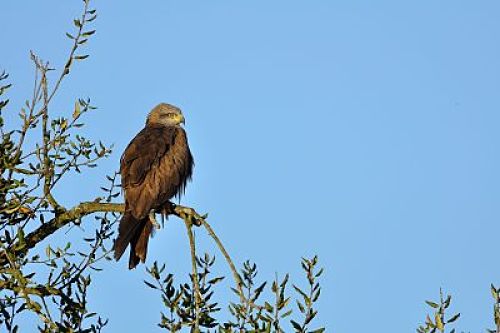Booted eagles and Black kites (Spain)
Competitive and predatory interactions between Booted eagles and Black kites in Doñana National Park: a GPS-satellite telemetry study

GPS-Locations of a breeding Black kite male
and a breeding Booted eagle male
This project is lead by Fabrizio Sergio of CSIC- Consejo Superior de Investigaciones Cientificas (Spanish National Research Council). In collaboration with Julio Blas, Fernando Hiraldo, Lidia López Jimenez, Alessandro Tanferna, Javier Chicano. This project receives funding from Ministerio de Ciencia y Innovación (Spanish Ministry of Science and Education) Junta de Andalucía and Natural Research.
Doñana National Park is a wetland-complex located in south-western Spain and is world-renown for its dense populations of top vertebrate predators. This setting offers ideal conditions to study the mechanisms and adaptations that allow predatory species with similar ecologies to coexist in a relatively small area. The raptor guild of the Park is strongly dominated in terms of abundance by an opportunistic bird of prey, the Black kite Milvus migrans, present with more than 500 pairs and capable of reaching extremely high concentrations (up to 30 pairs/km2). The second most abundant raptor in the community is the Booted eagle Hieraaetus pennatus. This species has been characterized by a steep, ongoing increase, which has brought the population from 1 territory in 1976 to more than 100 pairs in 2013. Together, these two species compose more than 80 % of the raptor assemblage of the whole park, both by number and by biomass. One of the striking aspects of the relationship between these two species is the major overlap in their use of resources (nests, foraging habitats, prey species) and their constant interaction through territorial fights, nest usurpation, kleptoparasitism etc. The objective of this study will be to quantify the niche overlap of the two species and examine the mechanisms that may promote their close, competitive coexistence.
In 2012, Natural Research funded 10 GPS-satellite tags which were fitted onto 10 adult Booted eagles (6 breeding males, 4 breeding females) in Doñana National Park. In 2013, we trapped and deployed GPS-satellite tags on a further eight adult eagles. Simultaneously, we obtained detailed data from 23 Black kite adult breeders which had been already marked with GPS-satellite tags in previous years. This will enable a simultaneous interspecific comparison of ranging behaviour and habitat selection across different portions of the park and across different stages of the breeding cycle. In parallel, we closely monitored more than 500 Black kite nests and more than 100 Booted eagle nests.
Overall, GPS data showed great heterogeneity in foraging behaviour and in the potential for interaction between the two species. While some eagle pairs nested relatively far from kites, others bred in close proximity and with extreme overlap in space use, habitat selection and diet composition. Given such extremes of niche overlap, both Black kites and Booted eagles are likely to face a highly dynamic social environment, setting the stage for the potential development of a range of strategies to cope with heterospecific interactions.



